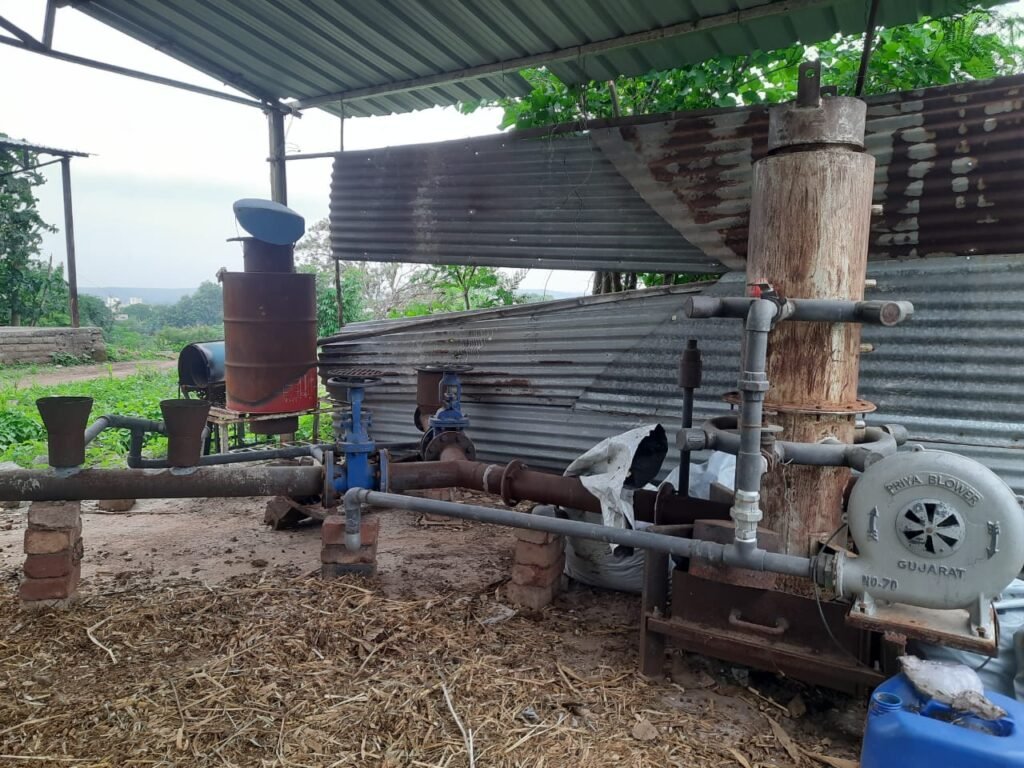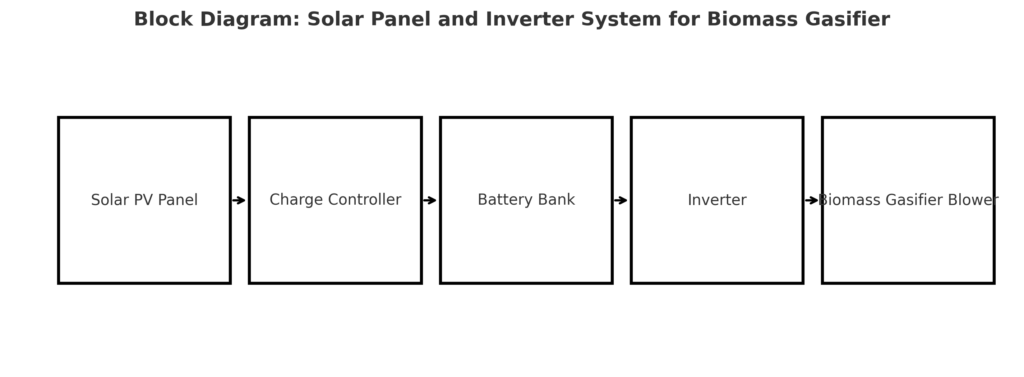OBJECTIVE
To design an integrated solar and inverter system to power the blower of a biomass gasifier and evaluate the techno-economic feasibility for clean cooking in rural areas.
Week 1 – Understanding initial system design and performed technical calculations for solar panels, inverter and battery.
What is a Biomass Gasifier?
A biomass gasifier is a device that converts solid biomass (like wood, crop waste, coconut shells, etc.) into a combustible gas called syn gas through a process called gasification.
It’s a cleaner and more efficient alternative to directly burning biomass.
How does it work?
A biomass gasifier performs partial combustion of biomass in a controlled oxygen environment.
Step-by-Step Process:
- Feed Biomass (wood chips, shells, crop husk, etc.)
- Ignite it in the combustion chamber (usually with a small amount of fuel or fire)
- Due to limited oxygen, it doesn’t fully burn — instead, it breaks down into gases like:
- Carbon monoxide (CO)
- Hydrogen (H₂)
- This gas is called syngas
- The gas is filtered and cooled, then used as fuel for:
- Cooking
- Electricity generation
- Heating
What is the Function of a Gasifier?
Convert solid waste into usable energy
Produce clean-burning gas from agricultural waste
Reduce dependency on LPG, diesel, or firewood
Why it’s useful for rural areas ?
- Uses locally available biomass
- Reduces LPG/firewood use
- Creates cleaner combustion
- Can work with solar for hybrid systems
- Low-cost and sustainable in the long run
Gasification Process
Gasification is a thermochemical process that converts solid fuels (like biomass, coal, or wood) into a combustible gas mixture, called producer gas or syngas, by partially burning it in a controlled environment with limited oxygen.
Biomass (CₓHᵧOₙ)+Limited O₂→CO+H₂+CH₄+Heat
CALCULATIONS
Energy needed per day
Blower of the gasifier is of 1 HP = 746W
Operating time = 4 hours
Energy needed per day = 746W*4 = 2984 WH = 3KWH / day approx
Capacity of inverter
746*2 (surge) = 1492 W = 1.5 – 2KW capacity
Solar PV Capacity
Load = 3KW
Solar hours = 5 hours/day
Assuming 30% loss factor
Solar panels never operate at 100% efficiency due to several real-world losses. To compensate for these losses we multiply by 1.3 (or 30% extra).
Dust and dirt on panels = 5-10%
Panel aging and temperature effects = 5-10%
Inverter and wiring losses = 5-10%
Shading, angle efficiency = 5-10%
Total losses = 25-30% so we multiply by 1.3
PV Capacity = (3000/5)*1.3 = 780W *1.3 = 1.2KW approx
Battery Capacity
4 batteries of 12 V
Ah = 3000/48 = 62.5 Ah
Lead acid batteries are discharged to 70-80% ( depth of discharge)
Thus 62.5/0.7 = 89.3 Ah = 100 Ah
So we’ll consider 4 batteries of 12V and 100 Ah
Tilt angle
18 to 20 degree facing due south ( latitude of Pabal = 18.7 degree N )
Week 2 – Economic analysis and market survey
Battery back up duration
Blower is of 1 HP
Battery is of 48V and 100 Ah
E = V*Q
= 48*100 = 4800Wh = 4.8 KWH
Safe discharge = 60 – 70 % = 65 %
4.8 * 0.65 = 3.12 KWH usable energy
Back up time = 3.12 KW/ 0.746 KW
= 4.18 hours = 4.2 hours
SAVINGS
Blower = 1 HP = 746W
Usage = 4 hours/day
Daily energy required = 746*4 = 2.984 = 3KWH/day
Monthly power savings = 3KWH/day * 30 = 90 KWH/month
Annual power savings = 90*12 = 1080 KWH/year
If blower runs on grid electricity :
India’s grid emits about 0.713 kg of CO2 per KWH
1080KWH/year * 0.82 = 770.04 CO2/year is avoided
If cooking was done using LPG :
LPG in India contains 14.2 Kg of LPG
1Kg of LPG = 3Kg of CO2
C3H8 + 5O2 = 3CO2 + 4H2O
Molecular mass of Propane = 44g/mol
Amount of CO2 = 3*44 = 132 g
44g propane gives 132g CO2
1Kg of propane gives 3Kg of CO2
So 1 cylinder = 42.6 Kg CO2 (14.2 *3 )
If the kitchen uses 2-3 cylinders per month , yearly usage is approximately 30 cylinders.
30*42.6 = 1278 Kg CO2/year from LPG
Grid electricity for blower = 770.04 Kg CO2
LPG cooking fuel = 1278 Kg CO2
Total = 2048.04 CO2/year
Savings
Grid electricity = 8-10 rupees per KWH
So 1080 KWH/year * 8 = 8640 = 9000 rupees per year approx
1 LPG cylinder of 14.2 Kg costs = 852.5
Assuming kitchen uses 2-3 cylinders per month
So, annually 2.5*12 = 30 cylinders
30*852.50= 25,575
Therefore, total savings = 25,575 + 9000 = 34,575 per year
Pay back period
Total investment / Annual savings = 1,50,000/34,575 = 4.33
Pay back period = 4-5 years
BIOMASS GASIFIER


Cost Breakdown for 1.5 kW Solar + Inverter System
| Component | Specification | Quantity | Unit Price (₹) | Total Cost (₹) |
|---|---|---|---|---|
| Solar PV Panels | 300 W, Monocrystalline | 5 panels | ₹7,500–₹8,000 | ₹37,500–₹40,000 |
| MPPT Charge Controller | 48 V, 60–80 A, solar-grade | 1 unit | ₹6,000–₹8,000 | ₹6,000–₹8,000 |
| Pure Sine Wave Inverter | 2–3 kW, 48 V hybrid inverter | 1 unit | ₹18,000–₹22,000 | ₹18,000–₹22,000 |
| Battery Bank | 12 V, 100Ah tubular lead-acid | 4 batteries (48 V) | ₹9,000–₹10,000 | ₹36,000–₹40,000 |
| Installation & Cabling | Wiring, mounting, labor, fuses | Lump sum | — | ₹10,000–₹12,000 |
Total cost ( including GST and transportation) = 1.2 – 1.5lakhs
Week 3&4 – Conducted financial assessment via dealer quotations.
Actively communicated with multiple solar equipment dealers to collect quotations, compare prices, and finalize three shortlisted options for the solar panel and inverter system.
Comparative Analysis of the three quotations received




